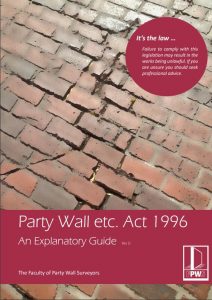Party Wall
Party Wall
For many people undertaking renovations, extensions or construction works on their home it can come as a surprise to discover that you need to have a party wall survey conducted and then have a party wall award / agreement drawn up between you and your neighbour. Listed below are examples of some of the most common types of works carried out where notification may be required under The Party Wall etc. Act 1996:
- Building an extension.
- Building a loft conversion.
- Building a conservatory.
- Excavations within 3m (or 6m for deep excavations) of the Adjoining Owner’s building.
- Underpinning the whole thickness of the party wall, along part or all of it.
- Demolishing and rebuilding the party wall.
Minor works such as installing shelves or wall units, replacing recessed electrical sockets, or re-plastering are generally regarded as not necessary for notification to neighbours. In light of this we’ve put together a brief resource of terms and procedures so that you understand more fully your role in this process and also to help you converse with your surveyor more effectively. Below are a handful of links to additional information.
- Building / Adjoining Owner Definitions
- What is a Party Wall?
- Party Wall Notices
- The Role of the Surveyor
- What is a Party Wall Award?
- Schedule of Condition
If you would like to receive a free initial consultation for your project please fill out the form provided. We will get back to you as soon as we can to discuss your project more fully and furnish you with a quote.
Building Owner
Building Owner
This is the person (or persons if jointly owned) or company who own(s) the land and who want(s) to undertake the works. Ownership of land is further defined in the Act.
Adjoining Owner
Adjoining Owner
Any owner and any occupier of land, buildings, storey or rooms adjoining those of the Building Owner and for the purposes of Section 6 [of the Act] within the distances specified in that section Accordingly, in respect of a single building, Adjoining Owners needing to be notified of impending works by the Building Owner may include a freeholder, a long leaseholder, one or more tenants and possibly sub-tenants.
What Is A Party Wall?
What Is A Party Wall?
In simple terms a party wall divides the buildings of two owners with the boundary between ownerships usually, but not always, positioned at the centre of the wall. The Party Wall etc. Act 1996 recognises two different types of party wall:
- A wall that stands astride the boundary of land belonging to two (or more) different owners. Examples include walls separating terraced or semi-detached houses or walls that form the boundary between two gardens, known as a “party fence wall” (see more detailed description below).
- A wall that stands wholly on one owner’s land, but is used by two (or more) owners to separate their buildings. Examples include where one neighbour has a structure that leans against a wall that is owned by the other neighbour. Only the part of the wall that is enclosed by the lean-to is a Party Wall.
Only the part of the wall that does the separating is “party” – sections on either side or above are not “party”.
What Is A Party Structure?
Party Structure
The Act also uses the expression “party structure”, which describes other dividing structures between properties such as floors or other partitions. These need to be considered when dealing with flats, or buildings with common parts such as lobbies etc.
Party Fence Wall
A wall is a “party fence wall” if it is not part of a building, and stands astride the boundary line between lands of different owners and is used to separate those lands (for example a garden wall). This does not include such things as wooden fences.
Party Wall Notices
Party Wall Notices
There are 3 types of notice that a Building Owner may serve upon an adjoining owner to make them aware that he intends to carry out work that falls under the scope of the Act.
-
-
- Party Structure Notice – Generally speaking these are alterations to the party wall itself and include common jobs such as cutting holes to insert beams and padstones, cutting in flashings and removing chimney breasts.
- Notice of Adjacent Excavation
- Excavating within 3 metres of your neighbour’s building and to a depth lower than the bottom of their foundations 4
- Excavating within 6 metres of your neighbour’s building, if any part of that excavation intersects with a plane drawn downwards at an angle of 45 degrees from the bottom of their foundations.
- Line of Junction Notice – The construction of a new wall adjacent to a boundary or the construction of a new wall astride a boundary.
It is obviously best to discuss your planned work fully with the Adjoining Owners before you (or your professional adviser on your behalf) give notice, in writing, about what you plan to do. You do not need to appoint a professional adviser to give the notice on your behalf, however using a Party Wall Surveyor will ensure the correct notices are served and the required information is contained within the notices. You will need to give at least 1 months notice (sometimes 2 months) before commencing works on the party wall, (although the adjoining owner can agree to allow the works to start earlier.)
Should you commence work without having given Notice, an Adjoining Owner may seek a Court Injunction to prevent you continuing and/or requiring you to remove any work already carried out.
Disputes
Disputes
The adjoining owner receiving the Notice(s) has three options available:
-
-
-
- Consent to the works as notified (this must be in writing)
- Dissent to the works
- Ignore the Notice
If, after a period of 14 days from the service of your notice, the person receiving the notice has done nothing, a dispute is regarded as having arisen. Section 10 of the Act stipulates that where an Adjoining Owner does not consent in writing to works notified by the Building Owner, (i.e. dissent) both parties must either agree on the appointment a single surveyor to act for both of them (known as the Agreed Surveyor) or each appoint their own surveyors, to determine the time and manner in which those works are carried out. The adjoining owner cannot frustrate the procedure by not appointing a surveyor. If they refuse to do so or fail to appoint one within 10 days of being requested to do so by the Building Owner, he may appoint one on the adjoining owner’s behalf. And, once a surveyor has been appointed, his appointment cannot be rescinded. Normally it is the Building Owner who pays the surveyor’s fees (for both building owner & adjoining owner) and any ancillary costs but there are exceptions.
The Role Of A Party Wall Surveyor
The Role Of A Party Wall Surveyor
The term “surveyor” is defined in the Act as any person not being a party to the matter appointed or selected under section 10 to determine disputes in accordance with the procedures set out in this Act. This means that neither the building owner, nor the adjoining owner is allowed to act as the surveyor. This means you can appoint almost anyone you like to act in this capacity. However the person chosen should be knowledgeable about construction and be well versed in party wall procedures, and ideally they should have a relevant qualification. If a dispute has deemed to have arisen you cannot reach agreement with the Adjoining Owners, the next best thing is to agree with them on appointing what the Act calls an “Agreed Surveyor” to draw up an “Award”. Alternatively, each owner can appoint a surveyor to draw up the award together. In all cases, surveyors appointed under the dispute resolution procedure of the Act must consider the interests and rights of both owners and draw up an award impartially. Once a dispute has arisen the Party Wall Surveyor(s) will prepare a document known as a “party wall award”. This agreement lays down recommended guidelines for the work to progress and covers details such as dates of commencement of the work, building contractor’s public liability insurance, reasonable working hours, etc. The surveyor will usually also draw up a schedule of condition of the adjoining owner’s property in order to properly assess damages should there be any damages inflicted on your neighbours property during construction works.
The Award will settle any matter (under the act), which is in dispute between Building and Adjoining Owners.
The surveyor(s) will produce a legal document known as an Award. The Award details the work to be carried out, when and how it will be done and usually records the condition of the relevant part of adjoining property before work begins. It may also grant access to both properties so that the works can be safely carried out and the surveyor/s can inspect work in progress.
An Award may determine:
-
-
-
- The right to execute any work
- The time and manner of executing any work
- Any other matter arising out of or incidental to the dispute including the costs of making the Award
Once the award has been agreed between the two surveyors it is “published”. In practical terms this means that their appointed surveyors send a signed and witnessed copy to the two owners. Although there is a 14 day right of appeal if either owner believes the award to have been improperly drawn up the award this is seldom observed. The Award will determine who pays for the work if this is in dispute. Generally, the building owner who started the work pays for all expenses of work and the reasonable costs, but these will be apportioned between the owners where appropriate.
Schedule Of Condition
Schedule Of Condition
(Commercial & Residential Surveys)
A condition survey provides a detailed documented and photographic representation of the physical condition of a property or building, varying upon the clients need for information and project.
-
-
-
- Adjoining owners gain documented proof supporting subsequent claims for damages
- Building owners are protected against potentially false or extravagant claims
It is standard practice for the relevant parts of an Adjoining Owner’s property to be inspected by the surveyor(s) in order to prepare a schedule of its condition before the Building Owner carries out any works. This safeguards not only the Building Owner from spurious claims but protects both parties position by establishing a reference point against which the extent of damage caused by the works, if any, can be assessed. Normally the schedule will be in written form, cross referenced to photographs, and be appended to an Award. It is not a requirement of the Act that such a schedule is prepared but legal judgments have indicated that the Courts expect surveyors to do so. Accordingly, it is in your interest to allow a survey to be undertaken. Should you refuse access for a schedule to be prepared, it will complicate matters for appointed surveyors if they need to assess any claim for damage and put you at a disadvantage should it be necessary for matters to proceed to Court.
Commercial Condition Surveys
Commercial Condition Surveys
A visual inspection is carried out of the existing condition of the site or premises. Photographs (video if requested) is used to illustrate deficiencies that may be found during the on-site inspection and a document details the existing condition, summarized in a brief report before and after the works.
Residential Condition Surveys
Residential Condition Surveys
Residential condition surveys are carried out if you’re concerned about damage being caused to your home due to building works by a neighbour or building site. This is also useful if no Party Wall Award is put in place but yet you still would like a survey in the unlikely even of damage being caused so that a claim can be supported.









